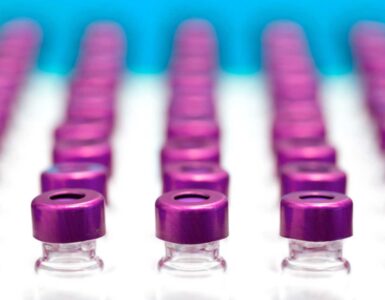As president, CEO and a co-founder of closely-held 4P Therapeutics, a leading developer of transdermal patches, Steve Damon cut his teeth in the sector at Altea Therapeutics and Durect. He was responsible for executing several key partnerships with various pharmaceutical companies for Altea’s novel transdermal patch technology, bringing over $45-million of non-dilutive financing to Altea. Prior to Altea, Mr. Damon had a stint at Durect where, in addition to completing product partnership agreements, he was responsible for certain commercial activities, including the Alzet brand drug delivery pumps and was president of a wholly-owned subsidiary, Absorbable Polymers International. In this interview with BioTuesdays.com, Mr. Damon discusses 4P’s unique business model, transdermal technologies and pipeline products.
Let’s begin with a history of 4P Therapeutics.
We formed 4P in September 2011, after Altea folded. The transdermal patch technology at Altea was advancing nicely, but the company was facing business issues that it couldn’t overcome. Fortunately, I was able to bring a number of key Altea scientists to 4P as well as David Enscore who, at Alza, led the development of the Nicoderm nicotine patch.
Can you describe your business model?
We are not investor-backed but have product partnerships in place that fund the company. We started with a very small founder investment and then grew the company by establishing partnerships and leveraging our transdermal know-how. In our case, necessity is the mother of invention. Our infrastructure is small but effective, utilizing in-house preclinical labs for product development, regulatory follow-through and a human clinic for Phase 1 studies.
That sounds like a very unique approach.
I think our story is unique because we are focused only on transdermal drug delivery and utilize all types of technologies necessary to develop a transdermal product. So, we are not a single-platform, drug delivery technology company. We have world-leading expertise in developing highly differentiated transdermal products for water-soluble, small molecules and biologics, as well as expertise in developing transdermal products as line extensions of existing drugs or improved generics.
How does that work in practical terms?
The first thing we do with a client is go through what I call an intellectual exercise to determine which type of delivery through the skin best suits the chemical characteristics of a particular drug and whether the resulting product can be commercially viable. All of our early R&D partnerships are funded by partners and goes directly to proof-of-concept work, which is where much of the risk is in drug delivery. Our share of success is back end-loaded through milestones and royalties, which is still as significant as other VC-backed drug delivery companies. So, when Big Pharma or Big Biotech comes to us and wants to know if we can make a patch with their drug, the answer is almost always “yes.” The big question is whether the product can be commercially viable. Because we are not married to any single technology platform, we can consider which transdermal technology will best suit any particular drug. As a result, proof-of-concept development is not an expensive undertaking.
Let’s run through some of the technologies you employ.
We work with passive and innovative transdermal technologies, such as microporation, microneedles, iontophoresis and patch pumps. There are tons of companies employing these technologies, but what we try to do is develop IP around a patch so that when we add a drug to a patch, it will lead to market exclusivity—even with generics.
What are the advantages of one technology over another?
Passive patches have once-daily to once-weekly application, which is suitable for line extensions of existing drugs or improved generic drugs. The drug is delivered through the skin via a solution or diffusion mechanism into the stratum corneum to be taken up by capillaries in the dermis.
Innovative transdermal patches are highly differentiated products that deliver small molecules and biologics. Microporation employs electrical, radio frequency or laser energy to create small micropores through ablation of the stratum corneum and has the ability to deliver both large and small water-soluble molecules such as parathyroid hormone, insulin, antibodies and fentanyl, for example. Microneedles use mechanical perforation to create channels through the stratum corneum in order to deliver both water-soluble small molecules and biologics. Microneedles primarily are used for a bolus administration of a discrete amount of medication but can also be used for sustained delivery of compounds such as parathyroid hormone, insulin and vaccines, among others.
What development successes have you had?
We have a proven track record of taking concepts from feasibility to the clinic on our own and with corporate partners. To date, we have successfully filed several INDs and conducted Phase 1 clinical trials of novel transdermal systems. One of our collaborations is focused on developing a transdermal formulation of Aggrastat, or tirofiban HCl, in partnership with Medicure (OTCQB:MCUJF; TSX-V:MPH). Aggrastat and other antiplatelet drugs of its type are currently only administered by intravenous infusion. The delivery of tirofiban by a novel transdermal means that it has the potential to provide significant advantages over the current treatments used in this setting, including the potential to facilitate pre-hospital administration. The fact that large pharma companies have spent many millions of dollars on attempts to introduce a non-intravenous, oral delivery form for this type of drug should serve as a testament to the tremendous market potential for this product and, most importantly, to the potential clinical benefit for patients.
How close is any of your projects to reaching market?
We have a transdermal patch in development with a generic drug that we think could be on the market in a little less than two years. Even ahead of that is a novel fentanyl patch for the management of moderate-to-severe pain, with abuse and misuse deterrent attributes. This is our own pipeline project with our own IP in place, and because the technology involves a material change, we think it could be on the market very quickly without the need to conduct any clinical trials. We are currently discussing partnerships around the technology.
What else is in the pipeline?
Everything else is early stage. In Type 2 diabetes, we think there’s an opportunity to develop a microporation transdermal patch to match the profile of a twice-daily injection of GLP-1. Our preclinical work has been successful. We’re also excited about a newly formulated, better generic version of scopolamine as an anti-nausea treatment, with the potential of reduced side effects. This could be another short-term development project. For migraine relief, we’re working on what could be the first prophylactic treatment for migraine headaches with a low dose transdermal patch of timolol. We also are developing a follicle-stimulating hormone patch for convenient and effective self-administration. For Parkinson’s disease, we’re looking for a partnership to develop a microporation patch to administer apomorphine for the prophylactic treatment of dyskinesia. Because there are skin irritation issues with the delivery of apomorphine, we’re working on a five- or six-hour patch that could stop involuntary muscle movements to aid Parkinson’s patients when they attend short-duration events.







